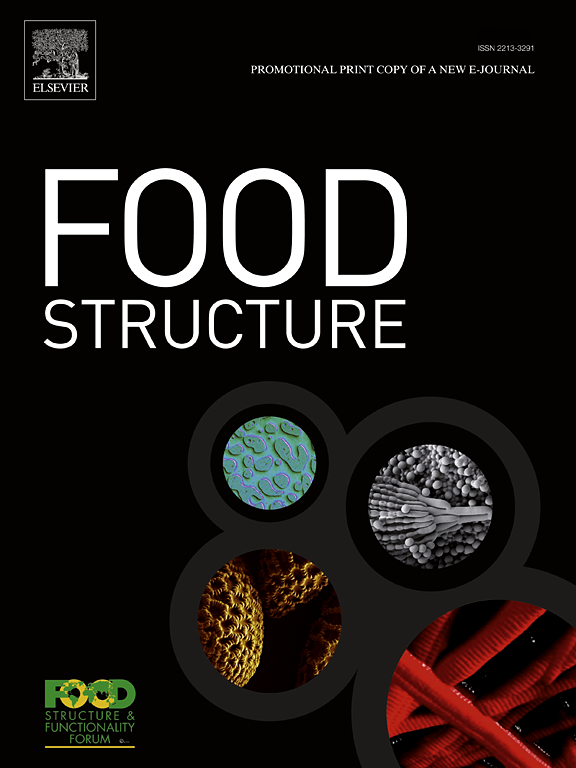Capillary flow-MRI of micronized fat crystal dispersions: Effect of shear history on microstructure and flow
IF 5.9
3区 农林科学
Q1 FOOD SCIENCE & TECHNOLOGY
引用次数: 0
Abstract
Micronized fat crystal (MFC) dispersions are a novel food ingredient enabling more efficient manufacturing of fat-based products as compared to established melt-cool processing. Yet, predicting rheological properties of MFC dispersions, remains a challenge. Here, we demonstrate how a capillary-flow Magnetic Resonance Imaging (MRI) platform provides quantitative measurements of local flow of MFC dispersions, inaccessible by global rheology. The measured 2D 1H MRI velocity maps unveiled a 5-fold velocity enhancement, and corresponding increase in wall slip, upon increasing the pre-shear time within 0–5 h, due to the 14 % increase in thickness of the crystalline nanoplatelets via recrystallization and aggregation of nanoplatelets. In the absence of pre-shearing, MFC dispersions exhibit an unsheared band at the walls of the capillary, likely arising from fouling and migration of thin nanoplatelets. In contrast to FCDs, flow cooperativity could not be observed for MFC dispersions due to the non-fractality of the fat crystal network. These results demonstrate that, by varying the pre-shear duration, the flow-microstructure properties of the MFC dispersions can be altered in a controlled manner. The approach presented here will allow for rapid assessment of shear-history dependence of flow properties of MFC dispersions under industrially relevant flow conditions.
微粉化脂肪晶体分散体的毛细管流-MRI:剪切历史对微观结构和流动的影响
微粉化脂肪晶体(MFC)分散体是一种新型食品配料,与传统的熔融-冷却加工相比,它能更高效地生产脂肪类产品。然而,预测 MFC 分散体的流变特性仍然是一项挑战。在这里,我们展示了毛细管流磁共振成像(MRI)平台如何对 MFC 分散体的局部流动进行定量测量,而全局流变学是无法实现这种测量的。测得的二维 1H 磁共振成像速度图显示,在 0-5 小时内增加预剪切时间后,速度增强了 5 倍,壁滑移也相应增加,这是由于结晶纳米颗粒的厚度通过纳米颗粒的再结晶和聚集增加了 14%。在没有预剪切的情况下,MFC 分散体在毛细管壁上会出现未剪切带,这可能是由于结垢和纳米薄片的迁移造成的。与 FCD 相反,由于脂肪晶体网络的非断裂性,MFC 分散液无法观察到流动合作性。这些结果表明,通过改变预剪切持续时间,可以以可控的方式改变 MFC 分散体的流动微结构特性。本文介绍的方法可以在工业相关的流动条件下快速评估 MFC 分散体流动特性的剪切历史依赖性。
本文章由计算机程序翻译,如有差异,请以英文原文为准。
求助全文
约1分钟内获得全文
求助全文
来源期刊

Food Structure-Netherlands
Chemical Engineering-Bioengineering
CiteScore
7.20
自引率
0.00%
发文量
48
期刊介绍:
Food Structure is the premier international forum devoted to the publication of high-quality original research on food structure. The focus of this journal is on food structure in the context of its relationship with molecular composition, processing and macroscopic properties (e.g., shelf stability, sensory properties, etc.). Manuscripts that only report qualitative findings and micrographs and that lack sound hypothesis-driven, quantitative structure-function research are not accepted. Significance of the research findings for the food science community and/or industry must also be highlighted.
 求助内容:
求助内容: 应助结果提醒方式:
应助结果提醒方式:


